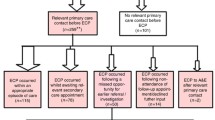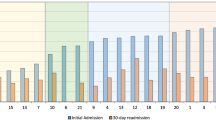Abstract
Purpose
People with cancer attend emergency departments (EDs) for many reasons. Improved understanding of the specific needs of these patients may assist in optimizing health service delivery. ED presentation and hospital utilization characteristics were explored for people with cancer and compared with those patients without cancer.
Methods
This descriptive, retrospective, multicentre cohort study used hospital administrative data. Descriptive and inferential statistics were used to summarise and compare ED presentation characteristics amongst cancer and non-cancer groups. Predictive analyses were used to identify ED presentation features predictive of hospital admission for cancer patients. Outcomes of interest were level of acuity, ED and inpatient length of stay, re-presentation rates and admission rates amongst cancer patients and non-cancer patients.
Results
ED (529,377) presentations occurred over the 36 months, of which 2.4 % (n = 12,489) were cancer-related. Compared with all other attendances, cancer-related attendances had a higher level of acuity, requiring longer management time and length of stay in ED. Re-presentation rates for people with cancer were nearly double those of others (64 vs 33 %, p < 0.001), with twice the rate of hospital admission (90 vs 46 %, p < 0.001), longer inpatient length of stay (5.6 vs 2.8 days, p < 0.001) and had higher inpatient mortality (7.9 vs 1.0 %, p < 0.001). Acuity and arriving by ambulance were significant predictors of hospital admission, with cancer-related attendances having ten times the odds of admission compared to other attendances (OR = 10.4, 95 % CI 9.8–11.1).
Conclusions
ED presentations by people with cancer represent a more urgent, complex caseload frequently requiring hospital admission when compared to other presentations, suggesting that for optimal cancer care, close collaboration and integration of oncology, palliative care and emergency medicine providers are needed to improve pathways of care.
Similar content being viewed by others
References
Australian Institute of Health and Welfare (2013) Australian hospital statistics 2012–13: emergency department care. Health services series no. 52. AIHW, Canberra
Barbera L, Taylor C, Dudgeon D (2010) Why do patients with cancer visit the emergency department near the end of life? CMAJ Can Med Assoc J J Assoc Med Can 182(6):563–568
Guddati AK, Kumar N, Segon A, Joy PS, Marak CP, Kumar G (2013) Identifying oncological emergencies. Med Oncol (Northwood, London, England) 30(3):669. doi:10.1007/s12032-013-0669-6
Chan A, Soh D, Ko Y, Huang YC, Chiang J (2014) Characteristics of unplanned hospital admissions due to drug-related problems in cancer patients. Support Care Cancer 22(7):1875–1881. doi:10.1007/s00520-014-2160-0
Mayer DK, Travers D, Wyss A, Leak A, Waller A (2011) Why do patients with cancer visit emergency departments? Results of a 2008 population study in North Carolina. J Clin Oncol 29(19):2683–2688. doi:10.1200/jco.2010.34.2816
International Statistical Classification of Diseases and Related Health Problems. 10th Revision. Australian Modification (ICD-10-AM) (2010) National Centre for Classification in Health (NCCH). http://sydney.edu.au/health_sciences/ncch/index.shtml. Accessed 20 April 2015
Barbera L, Atzema C, Sutradhar R, Seow H, Howell D, Husain A, Sussman J, Earle C, Liu Y, Dudgeon D (2013) Do patient-reported symptoms predict emergency department visits in cancer patients? A population-based analysis. Ann Emerg Med 61(4):427–437. doi:10.1016/j.annemergmed.2012.10.010, e425
Swenson KK, Rose MA, Ritz L, Murray CL, Adlis SA (1995) Recognition and evaluation of oncology-related symptoms in the emergency department. Ann Emerg Med 26(1):12–17
Tanriverdi O, Beydilli H, Yildirim B, Karagoz U (2014) Single center experience on causes of cancer patients visiting the emergency department in southwest Turkey. Asian Pac J Cancer Prev APJCP 15(2):687–690
Tsai SC, Liu LN, Tang ST, Chen JC, Chen ML (2010) Cancer pain as the presenting problem in emergency departments: incidence and related factors. Support Care Cancer 18(1):57–65. doi:10.1007/s00520-009-0630-6
Yates M, Barrett A (2009) Oncological emergency admissions to the Norfolk and Norwich University Hospital: an audit of current arrangements and patient satisfaction. Clin Oncol (Royal College of Radiologists (Great Britain)) 21(3):226–233. doi:10.1016/j.clon.2008.12.006
Vandyk AD, Harrison MB, Macartney G, Ross-White A, Stacey D (2012) Emergency department visits for symptoms experienced by oncology patients: a systematic review. Support Care Cancer 20(8):1589–1599. doi:10.1007/s00520-012-1459-y
McNamara BA, Rosenwax LK, Murray K, Currow DC (2013) Early admission to community-based palliative care reduces use of emergency departments in the ninety days before death. J Pall Med 16(7):774–779. doi:10.1089/jpm.2012.0403
Rosenwax LK, McNamara BA, Murray K, McCabe RJ, Aoun SM, Currow DC (2011) Hospital and emergency department use in the last year of life: a baseline for future modifications to end-of-life care. Med J Aust 194(11):570–573
Livingston P, Craike M, Considine J (2011) Unplanned presentations to emergency departments due to chemotherapy induced complications: opportunities for improving service delivery. Australas Emerg Nurs J 14:62–68. doi:10.1016/j.aenj.2011.03.005
McKenzie H, Hayes L, White K, Cox K, Fethney J, Boughton M, Dunn J (2011) Chemotherapy outpatients' unplanned presentations to hospital: a retrospective study. Support Care Cancer 19(7):963–969. doi:10.1007/s00520-010-0913-y
Leak A, Mayer DK, Wyss A, Travers D, Waller A (2013) Why do cancer patients die in the emergency department?: an analysis of 283 deaths in NC EDs. Am J Hosp Pall Care 30(2):178–182. doi:10.1177/1049909112445306
Aprile G, Pisa FE, Follador A, Foltran L, De Pauli F, Mazzer M, Lutrino S, Sacco CS, Mansutti M, Fasola G (2013) Unplanned presentations of cancer outpatients: a retrospective cohort study. Support Care Cancer 21(2):397–404. doi:10.1007/s00520-012-1524-6
Flowers CR, Seidenfeld J, Bow EJ, Karten C, Gleason C, Hawley DK, Kuderer NM, Langston AA, Marr KA, Rolston KV, Ramsey SD (2013) Antimicrobial prophylaxis and outpatient management of fever and neutropenia in adults treated for malignancy: American society of clinical oncology clinical practice guideline. J Clin Oncol 31(6):794–810. doi:10.1200/jco.2012.45.8661
Jefford M, Baravelli C, Dudgeon P, Dabscheck A, Evans M, Moloney M, Schofield P (2008) Tailored chemotherapy information faxed to general practitioners improves confidence in managing adverse effects and satisfaction with shared care: results from a randomized controlled trial. J Clin Oncol 26(14):2272–2277. doi:10.1200/jco.2007.14.7710
Gorham J, Ameye L, Berghmans T, Sculier JP, Meert AP (2013) The lung cancer patient at the emergency department: a three-year retrospective study. Lung Cancer 80(2):203–208. doi:10.1016/j.lungcan.2012.12.006
Courtney DM, Aldeen AZ, Gorman SM, Handler JA, Trifilio SM, Parada JP, Yarnold PR, Bennett CL (2007) Cancer-associated neutropenic fever: clinical outcome and economic costs of emergency department care. Oncologist 12(8):1019–1026. doi:10.1634/theoncologist.12-8-1019
Perrone J, Hollander JE, Datner EM (2004) Emergency department evaluation of patients with fever and chemotherapy-induced neutropenia. J Emerg Med 27(2):115–119. doi:10.1016/j.jemermed.2004.03.004
Demshar R, Vanek R, Mazanec P (2011) Oncologic emergencies: new decade, new perspectives. AACN Adv Crit Care 22(4):337–348. doi:10.1097/NCI.0b013e318230112b
van den Beuken-van Everdingen MH, de Rijke JM, Kessels AG, Schouten HC, van Kleef M, Patijn J (2007) Prevalence of pain in patients with cancer: a systematic review of the past 40 years. Ann Oncol 18(9):1437–1449. doi:10.1093/annonc/mdm056
Greenwald HP, Bonica JJ, Bergner M (1987) The prevalence of pain in four cancers. Cancer 60(10):2563–2569
Jelinek GA, Marck CH, Weiland TJ, Philip J, Boughey M, Weil J, Lane H (2013) Caught in the middle: tensions around the emergency department care of people with advanced cancer. Emerg Med Australas 25(2):154–160. doi:10.1111/1742-6723.12047
Gabriel J (2012) Acute oncological emergencies. Nurs Stand 27(4):35–42
Ahn S, Lee YS, Lim KS, Lee JL (2012) Emergency department cancer unit and management of oncologic emergencies: experience in Asan Medical Center. Support Care Cancer 20(9):2205–2210. doi:10.1007/s00520-012-1478-8
Ruegg TA (2013) A nurse practitioner-led urgent care center: meeting the needs of the patient with cancer. Clin J Oncol Nurs 17(4):E52–E57. doi:10.1188/13.CJON.E52-E57
Acknowledgments
This study was supported financially by a grant from the Victorian Comprehensive Cancer Centre.
Conflict of interest
The authors have no financial relationship with the funding agency and have no conflicts of interest to disclose. The authors have full control of all primary data and agree to allow the journal to review their data if requested.
Authorship contributions
All authors contributed equally, and each was involved in study design, data acquisition or data analysis/interpretation and in drafting or critically revising the manuscript. All authors reviewed the final manuscript and gave approval for submission.
Author information
Authors and Affiliations
Corresponding author
Rights and permissions
About this article
Cite this article
van der Meer, D.M., Weiland, T.J., Philip, J. et al. Presentation patterns and outcomes of patients with cancer accessing care in emergency departments in Victoria, Australia. Support Care Cancer 24, 1251–1260 (2016). https://doi.org/10.1007/s00520-015-2921-4
Received:
Accepted:
Published:
Issue Date:
DOI: https://doi.org/10.1007/s00520-015-2921-4




